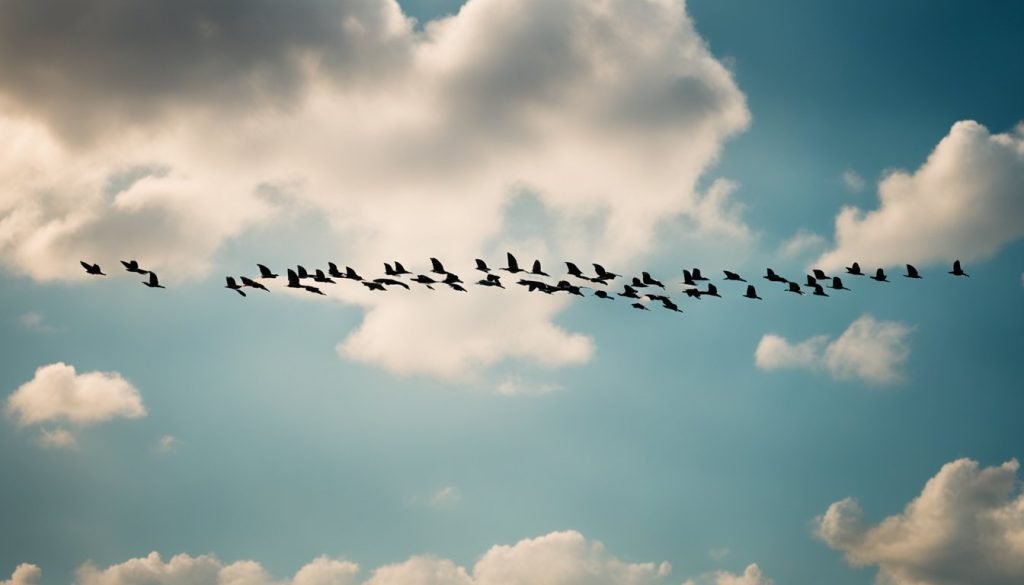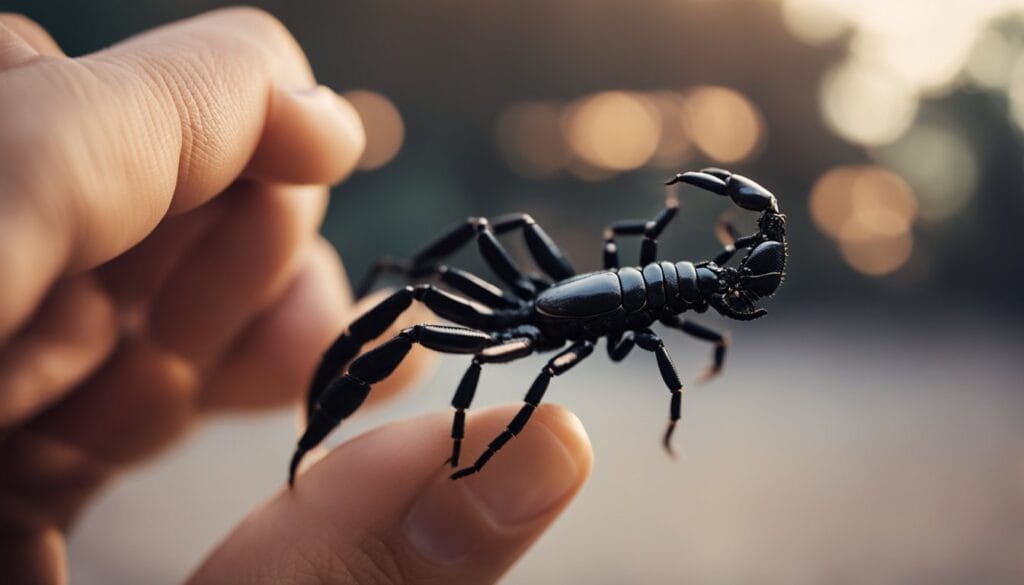Birds flying in a V formation can seem like just another natural phenomenon, but there’s more than meets the eye. Many believe this pattern carries deep spiritual meaning, offering insights into themes of unity and collective strength.

You might wonder why such a simple formation is so prevalent in nature. This arrangement aids in conserving energy and streamlining communication, but its symbolic resonance extends far beyond efficiency.
The way these birds fly together suggests a powerful symbol of harmony and cooperation.
Key Takeaways
- Birds in V formation symbolize unity and cooperation.
- This pattern reflects themes of personal and collective growth.
- Observing these formations offers insights into spiritual and social harmony.
The Phenomenon of Birds Flying in V Formation
When you look up at the sky and see birds flying in a V formation, it’s more than just a beautiful sight. This behavior is a mix of science, cooperation, and skilled flight. Let’s dive into why and how birds, especially geese, achieve this fascinating feat.
Understanding the V Formation
You might wonder why birds like geese choose a V formation. Think of it as a smart strategy for energy-saving. The lead bird does the hard work of breaking the wind, creating upward air currents that lift the following birds.
Studies show that birds flying in this pattern can travel up to 70% further than those flying solo. When the lead bird gets tired, it swaps places with another, showcasing excellent teamwork and mutual support. This way, each bird shares the role, ensuring the entire flock reaches its destination with energy and endurance to spare.
Why Birds Fly in a V Pattern
Birds often fly in a V pattern due to the aerodynamic advantages it provides. The V formation reduces air resistance and conserves energy.
By flying just behind and to the side of another bird, each bird benefits from the lift created by the bird in front of it.
The synchronicity of their wing flaps helps them maintain this formation efficiently. Aside from geese, many bird species, including pelicans and swans, adopt this formation.
It’s not just about energy conservation but also about leadership and cooperation within the flock.
Every bird gets a turn at leading, fostering unity and maximizing the flock’s endurance on long migrations. The science behind this behavior is a testament to nature’s ingenuity in combining aerodynamics and teamwork.
Spiritual Interpretations of Birds in V Formation

You might wonder why birds fly in a V formation and what it could signify spiritually. It’s fascinating how this natural phenomenon carries deep meanings across cultures and spiritual contexts.
Cultural and Historical Significance
Throughout history, many cultures have seen birds flying in a V formation as symbols of unity and cooperation.
For instance, Native American tribes often interpreted this behavior as a representation of community and teamwork.
In Christianity, V formations have been linked to divine guidance and protection, suggesting that a higher power is leading you on the right path.
ancient Egyptians saw birds in these formations as messengers of the gods, bringing important messages from the spiritual world.
Such interpretations underscore the belief that there’s a higher, organized force guiding collective actions towards a common goal.
Spiritual Messages Conveyed through Formation
Spiritually, seeing birds in a V formation can be a sign to trust your intuition and stay connected to your higher self.
Many believe it’s an indication you’re not alone in your journey and that spiritual beings are guiding you. This formation symbolizes alignment with your purpose and encourages you to seek transformation and growth.
It’s also seen as a sign of good luck and positive change, pushing you to look for insights and listen to messages from your subconscious. When you notice this formation, consider it a reminder to keep striving and trust that the universe supports you.
Social and Behavioral Aspects of V Formation

Birds flying in V formation demonstrate intricate social interactions and organizational structures. These behaviors underscore community, teamwork, and leadership that are essential for the flock’s success.
Community and Teamwork Among Birds
Birds in V formation rely heavily on community and teamwork to achieve efficiency and safety during flight.
Each bird benefits from the reduced air resistance created by the bird in front, conserving energy by flying in the slipstream.
This intricate collaboration enhances flight endurance, allowing birds to travel great distances without fatigue.
Communication is key to maintain the formation. Birds use vocalizations and visual cues to stay in sync, ensuring the group remains harmonious and balanced.
This collective effort means that every bird has a role, whether leading or following, which fosters a sense of interconnectedness within the flock.
Leadership and Roles Within the Flock
The lead bird plays a crucial role by breaking the headwind and setting the direction for the flock.
It takes significant effort and energy to be the lead bird, reflecting the leadership and commitment required.
Fascinatingly, birds often rotate leadership roles to share this burden, showcasing a dynamic system of support and guidance.
This rotational system ensures no single bird is overwhelmed, promoting balance and fair collaboration.
Other birds follow the lead with trust, demonstrating how effective leadership and a clear follow-ship can drive collective success.
By rotating leaders and maintaining communication, birds exhibit an extraordinary level of organization and interdependence.
Universal Themes Embodied by Flying in V Formation

Birds flying in a V formation aren’t just a spectacle; they symbolize unity, change, and adaptability. These themes resonate deeply, reflecting personal growth and the power of community.
Unity and Connection
When you see birds flying in a V formation, you witness a powerful demonstration of unity.
Each bird plays a crucial role in reducing wind resistance for the bird behind it, promoting collective consciousness.
This formation showcases the power of community, illustrating how working together can make challenging tasks more manageable.
You can think of it like a relay race, where taking turns leads to achieving a common goal.
This teamwork is essential for the birds’ long journeys, reflecting how unity can foster resilience and courage in the face of challenges.
You’re reminded that connection and support within a community can lead to extraordinary outcomes.
Change and Adaptation
Birds in a V formation also exemplify change and adaptation.
When the lead bird tires, it rotates to the back, allowing another to take its place.
This demonstrates an ability to adapt to changing circumstances, emphasizing the importance of mindful navigation through challenges.
This constant adjustment helps the flock maintain energy and control, showing how being adaptable creates opportunities for positive change and personal growth.
In essence, the V formation isn’t just about flight—it’s about thriving amidst change and leveraging the strength of the group to overcome obstacles.
Personal and Collective Growth Reflected in V Formation

Birds in V formation demonstrate valuable lessons in teamwork and unity. Their synchronized flight offers insights into shared goals and the power of collective strength.
Learning from Birds’ Cooperation
When birds fly in a V formation, each bird benefits from reduced air resistance, conserving energy and enabling longer flights.
This synergy highlights how cooperation leads to increased efficiency and fulfillment.
By taking turns leading, they share the hardship, fostering a collective spirit and shared awareness.
You can see this in how geese operate as a team, providing mutual support, and empowerment. This behavior illustrates the importance of working together towards common goals.
Much like in human endeavors, strength in numbers and cooperation result in greater achievements than flying solo.
Inspirations for Human Endeavors
Seeing birds in V formation can remind us of the power of unity and teamwork.
Just like these birds, humans can achieve more through shared goals and collective strength.
Think of a workplace where team members support one another, enhancing each other’s determination and maximizing potential.
This concept is vividly illustrated during large projects requiring extensive collaboration.
By aligning efforts and taking cues from nature’s wisdom, individuals within a group can mirror the fulfillment and empowerment seen in the V formation.
Working together, we accomplish more efficiently, driven by the same principles of mutual support and shared awareness.
Symbolic and Spiritual Insights

Birds flying in V formation carry profound symbolic and spiritual meanings. These themes frequently center on freedom, divine connection, and protection.
Freedom and Liberation
When you see birds in a V formation, it often symbolizes freedom and liberation.
Imagine the exhilarating feeling of flying without barriers, representing the soul’s journey toward independence.
This formation highlights resilience, overcoming adversity, and the pursuit of peace.
The leading bird in the V formation shares the responsibility, allowing others to benefit from its energy conservation.
Like in your spiritual journey, mutual support is crucial.
Birds take turns leading, emphasizing love, appreciation, and collective strength. This dynamic teaches us about the balance between leading and supporting within any community.
Divine Connection and Protection
Birds in V formation are also seen as messengers of divine connection and protection. They signify a link to the spirit world. This suggests that angels or divine beings are guiding and safeguarding you.
This formation serves as a reminder of divine intervention and the presence of higher perspectives. Witnessing this pattern can evoke a sense of peace and reassurance that you are on the right path. It reinforces the belief in divine guidance.
It emphasizes that you are never truly alone. As birds protect each other, you too are supported by a higher power through your spiritual journey.




